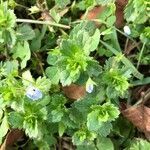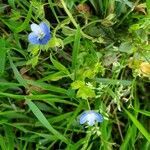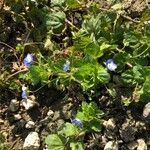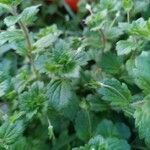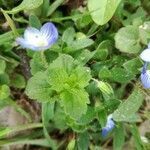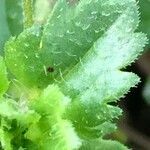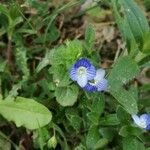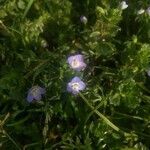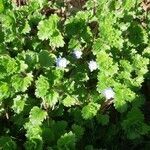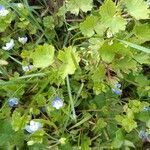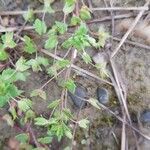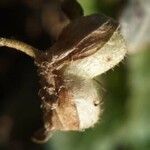Hairy, prostrate or semi-prostrate annual; stems many, decumbent, arising from near base, freely rooting at nodes, up to c. 70 cm long. Petioles to c. 1 cm long, usually shorter. Lamina 0.6-2.5 × 0.5-2 cm, ovate or broad-ovate, hairy, coarsely and irregularly crenate-serrate or serrate; base broad-cuneate, truncate or subcordate; apex obtuse to rounded. Fls axillary, solitary in axils of lvs similar to vegetative lvs; pedicels slender, > subtending lvs, to c. 4 cm long at fruiting, densely hairy. Calyx 5-7 mm long; lobes ovate-lanceolate to ± elliptic, ciliate, broad-cuneate to rounded at base, obtuse at apex. Corolla 10-15 mm diam.; 3 lobes bright blue; lowest lobe narrower, white to pale blue. Capsule c. 8 mm wide; lobes rounded, strongly divergent, sharply keeled, ± hairy. Seed broad-ellipsoid, strongly concave on 1 side, tuberculately ridged.
Somewhat villous-hirsute annual, the stems 1–4 dm, simple or branched especially below, loosely ascending and often rooting below; main lvs opposite, short-petiolate, the blade broadly elliptic or ovate, crenate-serrate, 1–2 cm, 1–1.5 times as long as wide; floriferous part of the stem elongate, with alternate bracts like the lvs, each with a single long-pedicellate axillary fl, the pedicel becoming 1.5–4 cm; cal-lobes lance-ovate, accrescent to 6–8 mm, becoming strongly 3-nerved; cor blue, (5–)8–11 mm wide; fr 5–9 mm wide, 3–5 mm high, divergently lobed, reticulately veined; style 1.8–3 mm; seeds 5–10 per locule, 1.2–1.8 mm, transversely rugose; 2n=28. Native of sw. Asia, intr. in gardens, lawns, roadsides and waste places throughout much of N. Amer. Apr.–Aug. (V. tournefortii)
Annual herb, decumbent, procumbent or Sub-Erect, up to 300 mm high or 600 mm long; stems slender, terete; sparsely pubescent. Leaves mostly alternate, opposite only at base; petiolate, ovate to rotund, up to 20 x 20 mm, margins crenate to dentate. Flowers single, axillary; pedicels up to 35 mm long, longer in fruit. Calyx 4-lobed, spreading, persistent. Corolla: tube short, 4-lobed, lobes spreading, light blue, sometimes with dark veins, ± 10 mm in diam. Stamens 2. Flowering time Aug.-Jan. Fruit a laterally flattened capsule, obcordate or kidney-shaped.
Annual herb. Stems procumbent, 0.1-0.6 m long. Leaves sessile or shortly petiolate; blade broadly ovate, 5-25 mm long, apex obtuse, base truncate, margins distinctly toothed or lobed. Flowers: solitary in leaf axils; bracts large, leaf-like; pedicels > 20 mm long; corolla 8-12 mm in diameter, blue and white; Jul.-Oct. Fruit with capsules keeled with divergent lobes.
Procumbent herb. Stems 100-600 mm long. Leaves broadly ovate, 5-25 mm long, truncate at base. Flowers solitary in leaf axils. Corolla 8-12 mm in diameter. Capsule keeled with divergent lobes. Flowers blue and white.
Prostrate, pubescent annual to 10 cm. Leaves petiolate, ovate, toothed, upper alternate. Flowers solitary in axils, blue; calyx accrescent. Capsules on deflexed pedicels, transversely 2-lobed, ± 7 mm diam.
A herb.
